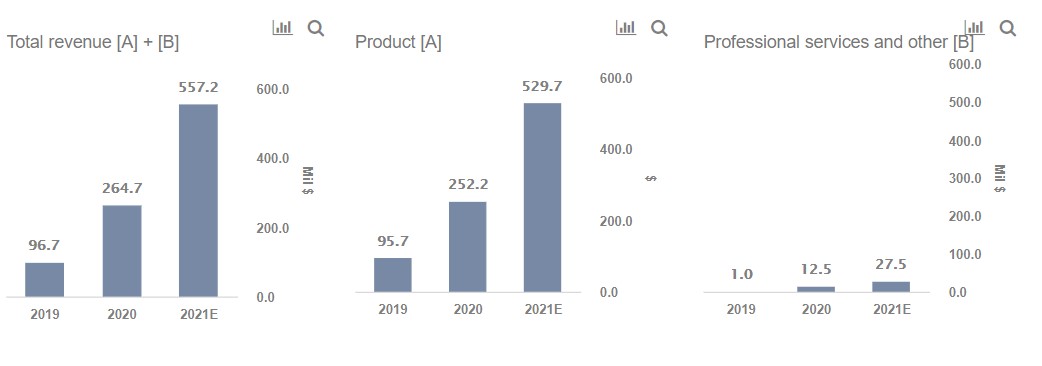Snowflake Looks Like A Risky Bet At A $60 Billion Plus Valuation
Snowflake (NYSE: SNOW), the cloud-based data warehousing company that went public recently, is valued at about $60 billion, or about $220 per share. The company trades at a whopping 230x trailing Revenues – well above many other high-growth SaaS names. Can Snowflake justify this valuation? In our interactive dashboard analysis on Snowflake’s Valuation: Expensive Or Cheap we break down the company’s revenues and valuation and compare it with other high-growth software players. Parts of the analysis are summarized below.
A Brief Look At Snowflake’s Business & Risks
Snowflake’s software enables organizations to manage and analyze large quantities and diverse types of data across public clouds such as Amazon’s AWS, Google Cloud, and Microsoft’s Azure in a single, easy to use platform. Snowflake stands to benefit as businesses increasingly move to the cloud while leveraging big data and artificial intelligence. Although major public cloud players have their own data warehousing solutions, (Amazon’s AWS offers Redshift, while Google offers BigQuery), Snowflake’s platform offers more flexibility compared to rivals and works well across platforms. However, the big cloud players have a strong incentive to promote their own warehousing offerings, as it enables them to lock customers into their platforms and services. There is a possibility that these companies could use their vast resources and control over their respective platforms to gain an edge over Snowflake.
- Up 7% This Year, Will Halliburton’s Gains Continue Following Q1 Results?
- Here’s What To Anticipate From UPS’ Q1
- Should You Pick Abbott Stock At $105 After An Upbeat Q1?
- Gap Stock Almost Flat This Year, What’s Next?
- With Smartphone Market Recovering, What To Expect From Qualcomm’s Q2 Results?
- Will United Airlines Stock Continue To See Higher Levels After A 20% Rise Post Upbeat Q1?
Snowflake’s Revenue
Let’s take a closer look at what’s driving Snowflake’s Revenue. Snowflake has two operating segments. 1) Products, which include Snowflake’s core data warehousing solutions. Customers pay according to the compute and storage that they use. 2) Professional Services – which includes consulting, on-site technical solution services, and training related to the platform.
Snowflake’s Product Revenue grew from $96 million in FY’19 to about $252 million in FY’20, as the company grew its customer base by 152% from 948 in FY’19 to 2,392 users. Based on the historical growth rate, and growth over Q2 (it had 3,117 customers as of July 2020), we expect Snowflake’s customer base to grow to about 4,600 in FY’21, with total Product revenues coming in at about $530 million. Snowflake’s Total Revenue, which includes its revenue from Professional Services grew from $97 million in FY’19 to about $265 in FY’20 and we expect it to grow 110% to about $557 million in FY’21.
Now Snowflake is not only adding new customers at a rapid clip, but it is also better monetizing its existing users. Snowflake’s Net Revenue Retention rate – which is the percent of revenue retained from the prior year after factoring for upgrades, downgrades, and churn – stood at 158%, indicating that existing customers continue to spend more.

Why Is Snowflake’s Trading At Such A Premium?
With benchmark interest rates at near-zero levels, investors have generally been paying a premium for growth. However, Snowflake stock, which trades at about 110x our projected FY’21 revenues for the company and over 230x FY’20 revenues appears pricey. Let’s compare Snowflake with other high growth SaaS and database players. Datadog trades at 76x trailing revenues and posted 83% revenue growth in 2020. Okta trades at 25x trailing revenues and posted 46% growth over its most recent fiscal year. MongoDB trades at 22x and posted 58% growth.
Sure Snowflake is growing faster than these companies, but there is another reason why the stock could be trading so high, namely a low supply of shares. Snowflake’s public float – which is the number of shares held by public investors – stood at just 28 million shares, or about 10% of its total shares outstanding and the low supply of shares is likely to have caused a bid up in the price. With Snowflake stock up almost 2x from its IPO price, it is very likely that employees and investors will choose to cash out as the post IPO lockup periods expire, putting downward pressure on the stock.
While Snowflake offers high growth, we think it comes with considerable risk at current prices. What if you’re looking for a more balanced portfolio instead? Here’s a high-quality portfolio to beat the market, with over 100% return since 2016, versus less than 50% for the S&P 500. Comprising companies with strong revenue growth, healthy profits, lots of cash, and low risk, it has outperformed the broader market year after year, consistently.
See all Trefis Price Estimates and Download Trefis Data here
What’s behind Trefis? See How It’s Powering New Collaboration and What-Ifs For CFOs and Finance Teams | Product, R&D, and Marketing Team
